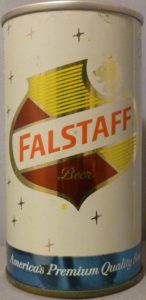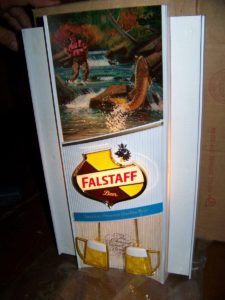
We’re all in this together. That was the message of Falstaff commercials I used to hear on the radio in the 70’s. Well, we may all continue to be in this together, but it’s sadly without Falstaff.
Falstaff beer had its start way back in 1840. That’s when German immigrant Adam Lemp established the Western Brewing Company in St. Louis. Lemp created a beer he called Falstaff. Eventually, Lemp’s brewery went out of business. In 1920, during Prohibition, a brewer by the name of Papa Joe Griesedieck stepped in and purchased the Falstaff brand name.
Papa Joe, possessing one of the most instantly recognizable names ever pronounced, was struggling, as were most other brewery and distillery owners. His brewery (which was officially renamed the Falstaff Corporation in 1920) produced de-spiked beer, soft drinks, and smoked hams. The mob was giving the public all of the hootch and beer that they wanted, so near-bear was a pretty sad performer in the marketplace (even though I now buy a case of Busch NA every couple of weeks ;-).
In 1933, the government finally repealed Prohibition, and the Falstaff brewery began a period of success that would peak in the mid 60’s, my beloved era of childhood memories.
Falstaff was all over the place during that decade. Billboards proclaimed its great taste. Cream sang its praises on radio commercials. A baseball or football game wasn’t watched on the idiot box or listened to on the radio without a Falstaff commercial or two.
I don’t know how to explain my fascination with Falstaff. Neither parent drank it. Mom was a Coors gal, dad preferred Miller. But there is a magical quality to the Falstaff name. It sounds good. It is majestic. It is SHAKESPEAREAN!

Ironically, I don’t think I ever drank a Falstaff. Back in the day, my parents would risk modern-day charges of child abuse by letting me sip a bit of their preferred libation on occasion, including, as I recall, while sitting at a traffic light in my current hometown of Bentonville, Arkansas during a visit back in 1968. How wrong is THAT?
And once beer started tasting good, at about the age of 18 (1978), Falstaff was confined to the section of the display case which contained Ballentine ale, Hamm’s, and Blatz. These once-proud brands were relegated to shells of their former selves by the the all-too cruel whims of the business world, and were now being brewed by companies which had bought them out and were no longer concerned with the tender care which their founders had given the original products.
Falstaff’s demise could be pinned on an ill-conceived acquisition. The company had a history of acquiring smaller breweries, but in 1965, they pushed their luck a little too far when they bought out a firm that you’ve probably never heard of: Narragansett Brewing Company of Cranston, R.I. Immediately, for some reason, the state of Rhode Island filed antitrust charges. Their attempt to block the sale would fail in court seven years later. It would also cause financial ruin for Falstaff.
The company had to pour lots of stockholder dollars into the legal battle. It also had to face the uncertain economy of the 70’s. And there were the advertising blitzes by rivals Anheuser-Busch, Miller, and Coors. The result was that by 1975, they were in dire financial straits. The company was sold to General Brewing, which also controlled Stroh’s, PBR, Olympia, and Pearl.
Thus began a slow death of the Falstaff brand which ended in 2005. That year, the General Brewing Company announced the end of the Falstaff brand name due to low volume of sales.
If you Google Falstaff, you’ll find that the beer still has a passionate following.
You’ll also find sites that pine for the brand, and pray for its resurrection. And I would like to see that myself. Not because of the long-lost taste, but because the name Falstaff was a treasured Boomer memory.
love the Falstaff beer bottles and cans, I feel the same way you do about the beer child hood memory..I am 70 years old, born
in Bentonville, Ar. in 1950
I remember the TV commercials with Eddie Mayehoff as The Old Pro. His dog was named Searchlight. I think…
I started tending bar in Mission KS in 1963 At 18 yrs old. The Keyhole was a small neighborhood bar with Falstaff on tap and the best selling bottles. Missouri girls
Had to come to Kansas to get served at 18, Mo was 21 for drinking age. One of the major perks was I waited on the girls and had reason to flirt with them which gained me a number of very attractive dates and long term girlfriends.